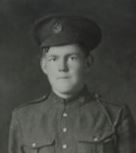Pte
Robert Roy McKibben
Informations sur naissance
|
Date de naissance: 25/09/1897 |
|
Lieu de naissance: Perham, Minnesota, États-Unis d'Amérique |
Informations générales
|
Profession: Ouvrier |
Informations service militaire
|
Pays: Canada |
|
Force armée: Canadian Expeditionary Force |
|
Rang: Private |
|
Numéro de service: 781446 |
|
Incorporation date: 15/12/1915 |
|
Incorporation nom de lieu: Moose Jaw, Saskatchewan, Canada |
|
Unités: — Canadian Infantry, 28th Bn. (North West) (Dernière unité connue) |
Informations sur décès
|
Date de décès: 07/11/1917 |
|
Lieu de décès: No. 44 Casualty Clearing Station, Nine Elms, Poperinge, Belgique |
|
Cause du décès: Died of wounds (D.O.W.) |
|
Âge: 20 |
Cimetière
|
Nine Elms British Cemetery Parcelle: VIII Rangée: C Tombe: 7 |
Distinctions et médailles 2
|
British War Medal Médaille |
|
Victory Medal Médaille |
Points d'intérêt 3
| #1 | Lieu de naissance | ||
| #2 | Lieu d'enrôlement | ||
| #3 | Lieu du décès (approximatif) |
Mon histoire
Private Robert Roy McKibben served in the Canadian Infantry 28th Battalion, which was part of the 6th Brigade of the 2nd Canadian Division. On 6 November 1917 the 27th, 31st and 28th Battalion of the 6th Brigade, together with the 2nd Brigade of the 1st Canadian Division, attacked the village of Passchendaele. This attack was part of the Second Battle of Passchendaele, the final stage of the Third Battle of Ypres.
At 6.00 a.m. the allied artillery opened up an incredibly heavy artillery barrage on the crest of the Passchendaele Ridge. The attack was accompanied with an enormous amount of shellfire on both sides, but the swampy nature of the ground made a lot of shells to misfire. The Germans defended the Passchendaele ridge with machinegun fire from pill-boxes, situated at strategic points, like crossroads and ruined farms. The German main line of defence ran along the Passchendaele-Mosselmarkt Road. This line however lacked the protection of concrete dug-outs and many Germans were killed due to the allied barrage, others were quickly seen fleeing from the line, but the concrete pill-boxes still remained a threat. Notwithstanding the heavy machine gun fire the advancing troops pressed on, outflanking and clearing the pill-boxes.
By 7.40 a.m. all Companies had reached their objectives. Consolidation was completed shortly after 10.00 a.m. The Battalion suffered 35 casualties during the attack itself. However once the men occupied the hillcrest the Germans put down a heavy barrage on the Canadians. On top of this the Canadian troops were frequently strafed by German aeroplanes. Parties of stretcher bearers encountered great difficulties in evacuating the wounded, due to the shelling and the ghastly state of the ground.
Private Robert Roy McKibben was gravely injured during the attack of 6 November 1917. He sustained shrapnel wounds to his abdomen and was evacuated to No. 44 Casualty Clearing Station, at Nine Elms in the town of Poperinge. He succumbed to his wounds on the following day and was buried at the adjacent Nine Elms British Cemetery.
At 6.00 a.m. the allied artillery opened up an incredibly heavy artillery barrage on the crest of the Passchendaele Ridge. The attack was accompanied with an enormous amount of shellfire on both sides, but the swampy nature of the ground made a lot of shells to misfire. The Germans defended the Passchendaele ridge with machinegun fire from pill-boxes, situated at strategic points, like crossroads and ruined farms. The German main line of defence ran along the Passchendaele-Mosselmarkt Road. This line however lacked the protection of concrete dug-outs and many Germans were killed due to the allied barrage, others were quickly seen fleeing from the line, but the concrete pill-boxes still remained a threat. Notwithstanding the heavy machine gun fire the advancing troops pressed on, outflanking and clearing the pill-boxes.
By 7.40 a.m. all Companies had reached their objectives. Consolidation was completed shortly after 10.00 a.m. The Battalion suffered 35 casualties during the attack itself. However once the men occupied the hillcrest the Germans put down a heavy barrage on the Canadians. On top of this the Canadian troops were frequently strafed by German aeroplanes. Parties of stretcher bearers encountered great difficulties in evacuating the wounded, due to the shelling and the ghastly state of the ground.
Private Robert Roy McKibben was gravely injured during the attack of 6 November 1917. He sustained shrapnel wounds to his abdomen and was evacuated to No. 44 Casualty Clearing Station, at Nine Elms in the town of Poperinge. He succumbed to his wounds on the following day and was buried at the adjacent Nine Elms British Cemetery.
Sources 4
|
Dewitt G.E., The Story of the Twenty-Eight (Northwest) Battalion, 1914-1917, (London, Charles & Son, s.d)., pg. 22-24. Sources utilisées |
|
McCarthy C., Passchendaele. The Day-by-Day Account, (London, Uniform, 2018), pg. 160-161. Sources utilisées |
|
Personnel Records of the First World War (Library and Archives Canada, Ottawa (LAC) RG 150, Accession 1992-93/166, Box 6991 - 2). https://www.bac-lac.gc.ca/eng/discover/military-heritage/first-world-war/personnel-records/Pages/search.aspx Sources utilisées |
|
War diaries: 28th Canadian Infantry Battalion (Library and Archives Canada, Ottawa (LAC), RG9-III-D-3, Volume number: 4935, Microfilm reel number: T-10739--T-10740, File number: 425 https://library-archives.canada.ca/eng Sources utilisées |
Complément d’informations 4
|
Commonwealth War Graves Commission Database https://www.cwgc.org/find-records/find-war-dead/casualty-details/137083 |
|
Namenlijst (In Flanders Fields Museum) https://namenlijst.org/publicsearch/#/person/_id=c856cef1-bc6c-4f10-824d-dac167d8098b |
|
Lives of the First World War (Imperial War Museum) https://livesofthefirstworldwar.iwm.org.uk/lifestory/5637033 |
|
The Canadian Virtual War Memorial https://www.veterans.gc.ca/eng/remembrance/memorials/canadian-virtual-war-memorial/detail/137083 |
